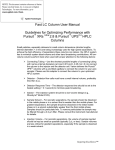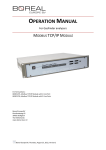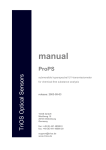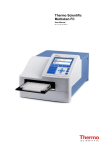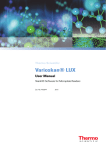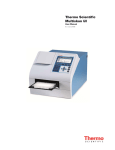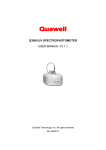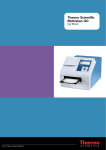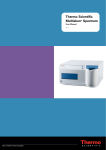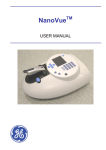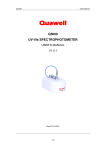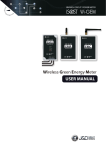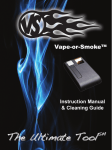Download Get the Most out of Your µDrop Plate
Transcript
Thermo Scientific μDrop Plate 1 Te ch ni cal N ote Marika Raitio, Thermo Fisher Scientific, Vantaa, Finland μDrop Plate: Get the Most out of Your µDrop Plate This paper aims to help you to get the best out of the Thermo Scientific µDrop Plate. properly cleaned. In normal conditions, average blank is probably the most convenient. Carry-over The µDrop Plate is intended for photometric low volume and cuvette measurements. The plate is compatible with Thermo Scientific Multiskan GO and Varioskan Flash instruments. In the case of a µDrop Plate, carry-over means that the plate is not properly cleaned, and some leftover from the previous sample affects the following measurement. Accuracy How to avoid carry-over? Clean the plate thoroughly after every measurement as instructed in User manual or below in this document. Accuracy of a reader means its ability to measure the true value. Cleaning This document concentrates mainly on nucleic acid measurements. The accuracy of the result gained with µDrop Plate always depends on the specification of the instrument it is used with. Blanking Any photometric measurement device, cuvette, microplate or µDrop Plate, always has some background absorption. Therefore, blank subtraction is always necessary in photometry when quantification of the sample is performed. No blanking is not an option! How to perform blanking? There are several ways to perform blanking with the µDrop plate: The µDrop Plate can be simply wiped clean between the samples in a series. Wipe the samples with a dry lens tissue or soft cloth. The lens tissue must not contain silicon. Between (or in) the measurement series, the low-volume area should be cleaned with a lens tissue dampened with de-ionized distilled water and after that with 70% ethanol. The cleanliness of the plate can be verified with a buffer measurement. • Pipette buffer into each well. Check that there are no air bubbles in the sample. Use the buffer and measurement wavelength used in the daily routine measurement. • Measure the absorbance in each well. • Average: The average of blank samples is subtracted from all other samples. This can be performed within the same plate or at a separate measurement. • Sample specific: The blank is measured before the sample in the exactly same sample well. • 320 nm subtraction: This is actually background correction and not blanking. 320 nm is a wavelength, at which the absorbance of both proteins and nucleic acids is minimal and an elevation in the 320 nm value indicates turbidity in the sample. This subtraction is recommended especially when magnetic beads have been used for the nucleic acid purification, since any beads remaining in the sample strongly scatter light. What to expect? Sample specific blanking gives better performance if the sample area is somehow affected (e.g. scratched) or not • The absorbance value of a clean sample position should be low, below 0.050 Abs. If the absorbance level is too high, clean the plate thoroughly. The blank sample spectrum is also an excellent tool for troubleshooting and cleanliness verification. Avoid touching the glass surface and always use disposable gloves when cleaning the plate. 2 Detection range For the µDrop Plate the lower part of the detection range is determined by the precision of the blank (Limit of detection (LOD) , sensitivity) and the upper part by the linear range of the instrument. A theoretical comparison of a dsDNA measurement with a 10 mm cuvette, microplate and the µDrop Plate lowvolume area with an instrument which has the specified precision of 0.003 and which is linear up to 2.5 abs, is shown in Figure 1. b) Linear range Because of the short pathlength, the concentration that can be measured with the µDrop Plate without dilutions is tens of times higher, than with a normal spectrophotometer. For example Multiskan GO can linearly measure from a cuvette up to 2.5 Abs, which in case of dsDNA is theoretically 2.5 * 50 µg/ml = 125 µg/ml With the µDrop Plate the measurable maximum concentration depends on the photometer: • Multiskan GO: 2.5 * 50 µg/ml * (10 mm/0.5 mm) = 2500 µg/ml • Varioskan Flash: 4 * 50 µg/ml * (10 mm/0.5 mm) = 4000 µg/ml c) Precision Precision means the repeatability of successive measurements. In photometric measurements, it is normally given as standard deviation (SD) Figure 1. The theoretical difference between the detection ranges of a cuvette, 384-well microplate and the µDrop Plate. a) Sensitivity The sensitivity of the assay is determined according to IUPAC: Limit of Detection (LOD). LOD is the lowest amount of analyte that can be separated from the background. It is calculated based on calibration curve slope vs. blank + 3* SD of the blank. LOD means, that this amount of analyte can be detected with statistical significance, but not necessarily quantified as an exact value. What to expect: With a µDrop Plate type of a measurement device, the theoretical detection limit is always determined by the instrument, i.e. the precision of the blank (LOD). In µDrop plate measurements, it depends on the photometer’s precision specification. Because of the short pathlength, the absorbances caused by the low concentration samples are really low, only a few milli absorbances. This means that the variation (SD) of these samples is naturally a lot higher than for the same samples on a longer pathlength. How to avoid low precision? Because of the small measurement area, the µDrop plate is vulnerable to bubbles and extra particles. To ensure high precision: • Mix the samples thoroughly • Clean the plate thoroughly For example with Multiskan GO, which has a precision specification of 0.003 Abs, the theoretical detection limit is 3*0.003*50 µg/ml*10 mm/0.5 mm) = 9 µg/ml • Preferably use the reverse pipetting technique What to expect on µDrop plate: Five dsDNA samples were measured with a semimicro cuvette, 384-well UV plate and µDrop Plate (Table 1). 3 Sample UV semimicro Cuvette µDrop Plate 384-well UV plate (µg/ml) (µg/ml) CV% (µg/ml) CV% 1 1.3 0.9 (below range) 50 0.9 10 2 5.1 4.8 10 4.3 1 3 23.2 23.5 5 22.6 0,5 4 114.8 118.5 1 113.2 0,5 5 Over range 588.1 1 Over range - Table 1. Five samples measured with a semimicro cuvette, 384 well UV plate and µDrop Plate. For the plates n=8. The 384-well plate volume was 50 µl and the pathlenght therefore ≈ 5 mm. Over range means, that the absorbance value is outside the photometer’s linear range. Below range means below the theoretical sensitivity limit. Extinction factor The extinction factor is needed to calculate the concentration of a sample according to the Lambert –Beer equation. For example, an Absorbance of 1.0 at 260 nm correlates to 50 μg/ml of dsDNA. The following table gives the average values generally used for nucleic acids. Empty plate Do not measure empty wells, as the reflections may cause strange results. The reflection is a lot stronger between quartz and air than between quartz and water. Nucleic acid Extinction coefficient (µg/ml) cm-1 1.0 Abs corresponds to (µg/ml) dsDNA 0.020 50 ssDNA 0.030 33 Evaporation RNA 0.025 40 Because of the very small sample volume, evaporation plays a more significant role than in, for example microplate measurements. Oligos 0.033 30 This is even more important with the µDrop Plate compared with a normal microplate, due to a doubling of the reflecting surfaces. What to expect: Evaporation will result in higher concentrations. Example: a blank subtracted abs value of 0.045 of a dsDNA sample on a µDrop Plate with pathlength of 0.51 mm would mean: 0.045 * 50 µg/ml * (10/0.51) = 44.1 µg/ml For example, very slowly pipetting eight sample replicates would cause the first replicates to give remarkably higher results than the last replicates. Linearity How to avoid evaporation: • Pipette as rapidly as possible • Measure the plate immediately after pipetting • Use an eight-channel pipette whenever possible • Though 2 µl is adequate to fill the sample area, use a slightly greater volume, whenever possible. • Do not perform long kinetic measurements Linearity describes the difference between the instrument’s measurement values and a known standard over the full range of the expected values. For photometers the upper part of the absorbance area (high concentrations) is especially difficult, because less and less photons reach the detector. For example, the following specification: 0-2.5 Abs (96well plates) at 450 nm, ±2%, means that up to 2.5 abs on a 96 well plate, the measured value differs less than ±2% from the linear value at 450 nm. The µDrop Plate is made of aluminium and quartz glass similar to microscope glasses. The low volume area is partly covered with Teflon (PTFE). Phenol and guanidium salts strongly absorb at 230nm. Therefore, this wavelength can be an indication of contamination of these compounds. Nucleic acid samples with 260/280 ratios of 1.8-2.2 and 260/230 ratios of 1.8-2.2 are generally considered pure Measurement The µDrop Plate does not limit the use of measurement steps in SkanIt Software compared with a normal 96 microplate. The only limitation is the sample area (columns 2 and 3). The USB memory stick provided with the µDrop Plate contains some ready-made sessions. It is also possible to perform measurements with the internal software of Multiskan GO. In this case the user needs to perform possible calculations in a separate software, such as Microsoft Excel. Magnetic beads may cause scattering, and therefore 320 nm subtraction is especially recommended with samples purified with those also for the ratio calculations. Replicates The use of several replicates is always recommended. In general, a greater number of replicates provides higher precision and thus more reliable results. Sample Other methods Compared to the fluorometric methods, the photometric method is cheaper and simpler, but the major disadvantages of the absorbance method are the large relative contribution of nucleotides and the interference caused by contaminants. For example, it is possible to measure the nucleic acid concentration also by using fluorometric stains. The fluorometric method is more sensitive, e.g the Quant-iT™ PicoGreen® dsDNA reagent enables quantification down to 25 pg/mL of dsDNA. However, it requires more assay steps, and is more expensive. Pathlength The pathlength of the µDrop Plate is the distance between the quartz glass surfaces, i.e. the length of the light beam in the liquid sample. Absorbance always depends on the pathlength and when pathlength is shorter, it is possible to measure higher concentrations. It is therefore possible to measure higher concentrations with the µDrop Plate than with for example a 10 mm cuvette. Ratios: 260/280 and 260/230 Both the A260/A280 and 260/230 ratios give an indication of the sample purity. Use only properly purified samples. The 260/280 nm and 260/230 nm ratios described above are useful tools for evaluating the quality of the sample. Close the lid gently to avoid splashing. Bubbles or dirt on the sample may affect the measurements. If the results seem erroneous: 1. Check that there are no air bubbles in the sample 2. Check that all the quartz surfaces are clean and unscratched Session A session refers to a measurement protocol and possible corresponding data in SkanIt Software. Spectrum It is not necessary to measure the spectra of all the samples, but it is a very good troubleshooting tool. Volume The usable volume of a sample for the µDrop plate is 2-10 µl. The greater the volume, the smaller the effect of evaporation. Proteins (especially due to Tyrosine and Tryptophan) strongly absorb at 280 nm. Therefore Abs280 is generally used as an indicator of protein contamination. thermoscientific.com/platereaders © 2012 Thermo Fisher Scientific Inc. All rights reserved. All trademarks are the property of Thermo Fisher Scientific Inc. and its subsidiaries. Specifications, terms and pricing are subject to change. Not all products are available in all countries. Please consult your local sales representative for details. North America: USA/Canada +1 603 595 0505 USA toll free 800 345 0206 Europe: Austria +43 1 801 40 0 Belgium +32 53 73 42 41 Finland +358 9 3291 0200 France +33 2 2803 2000 Germany national toll free 08001-536 376 TTMIuDrop_0512 Germany international +49 6184 90 6940 Italy +39 02 95059 552 Netherlands +31 76 571 4440 Nordic/Baltic countries +358 9 329 100 Russia/CIS +7 (495) 739 76 41 Spain/Portugal +34 93 223 09 18 Switzerland +41 44 454 12 12 UK/Ireland +44 870 609 9203 Asia: Australia +613 9757 4474 China + 86 21 6865 4588 or +86 10 8419 3588 China toll free 800-810-5118, 400-650-5118 India +91 22 6716 2200 Japan +81-3-5826-1616 Korea +82 11 796 7771 Other Asian countries +65 6872 9717 Countries not listed: +49 6184 90 6940 or +33 2 2803 2000 Te ch ni cal N ote Material




